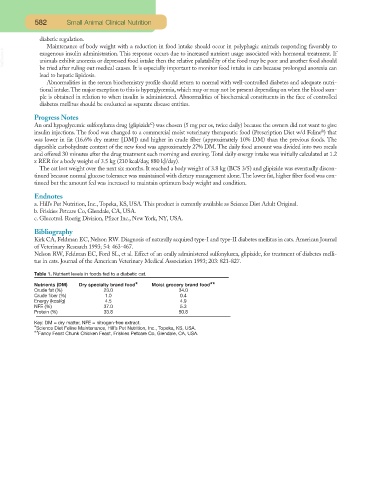Page 563 - Small Animal Clinical Nutrition 5th Edition
P. 563
582 Small Animal Clinical Nutrition
diabetic regulation.
Maintenance of body weight with a reduction in food intake should occur in polyphagic animals responding favorably to
VetBooks.ir exogenous insulin administration. This response occurs due to increased nutrient usage associated with hormonal treatment. If
animals exhibit anorexia or depressed food intake then the relative palatability of the food may be poor and another food should
be tried after ruling out medical causes. It is especially important to monitor food intake in cats because prolonged anorexia can
lead to hepatic lipidosis.
Abnormalities in the serum biochemistry profile should return to normal with well-controlled diabetes and adequate nutri-
tional intake.The major exception to this is hyperglycemia, which may or may not be present depending on when the blood sam-
ple is obtained in relation to when insulin is administered. Abnormalities of biochemical constituents in the face of controlled
diabetes mellitus should be evaluated as separate disease entities.
Progress Notes
c
An oral hypoglycemic sulfonylurea drug (glipizide ) was chosen (5 mg per os, twice daily) because the owners did not want to give
a
insulin injections. The food was changed to a commercial moist veterinary therapeutic food (Prescription Diet w/d Feline ) that
was lower in fat (16.6% dry matter [DM]) and higher in crude fiber (approximately 10% DM) than the previous foods. The
digestible carbohydrate content of the new food was approximately 27% DM. The daily food amount was divided into two meals
and offered 30 minutes after the drug treatment each morning and evening.Total daily energy intake was initially calculated at 1.2
x RER for a body weight of 3.5 kg (210 kcal/day, 880 kJ/day).
The cat lost weight over the next six months. It reached a body weight of 3.8 kg (BCS 3/5) and glipizide was eventually discon-
tinued because normal glucose tolerance was maintained with dietary management alone.The lower fat, higher fiber food was con-
tinued but the amount fed was increased to maintain optimum body weight and condition.
Endnotes
a. Hill’s Pet Nutrition, Inc., Topeka, KS, USA. This product is currently available as Science Diet Adult Original.
b. Friskies Petcare Co, Glendale, CA, USA.
c. Glucotrol. Roerig Division, Pfizer Inc., New York, NY, USA.
Bibliography
Kirk CA, Feldman EC, Nelson RW. Diagnosis of naturally acquired type-I and type-II diabetes mellitus in cats. American Journal
of Veterinary Research 1993; 54: 463-467.
Nelson RW, Feldman EC, Ford SL, et al. Effect of an orally administered sulfonylurea, glipizide, for treatment of diabetes melli-
tus in cats. Journal of the American Veterinary Medical Association 1993; 203: 821-827.
Table 1. Nutrient levels in foods fed to a diabetic cat.
Nutrients (DM) Dry specialty brand food* Moist grocery brand food**
Crude fat (%) 23.0 34.0
Crude fiber (%) 1.0 0.4
Energy (kcal/g) 4.5 4.9
NFE (%) 37.0 5.3
Protein (%) 33.8 50.8
Key: DM = dry matter, NFE = nitrogen-free extract.
*Science Diet Feline Maintenance, Hill’s Pet Nutrition, Inc., Topeka, KS, USA.
**Fancy Feast Chunk Chicken Feast, Friskies Petcare Co, Glendale, CA, USA.

